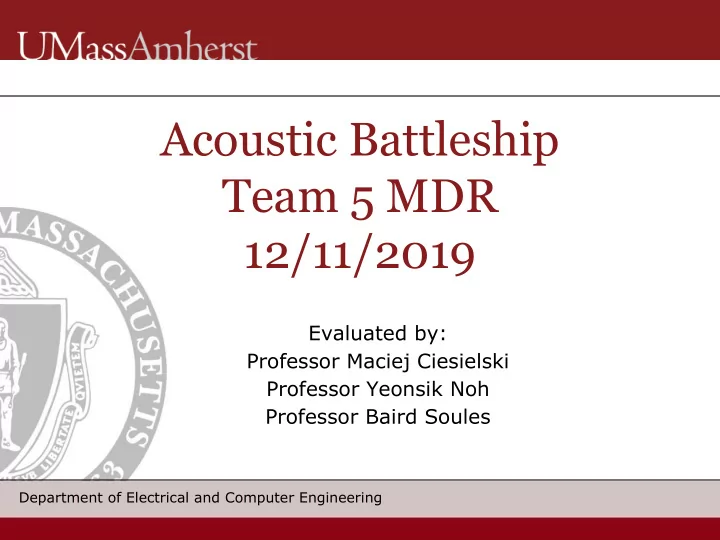

Acoustic Battleship Team 5 MDR 12/11/2019 Evaluated by: Professor Maciej Ciesielski Professor Yeonsik Noh Professor Baird Soules Department of Electrical and Computer Engineering
Team Members Liam Weston Adrian Sanmiguel (Group Manager) Xinyu Cao Justin Forgue Department of Electrical and Computer Engineering 2
Problem Statement Board games have failed to adapt to the technological advances of today’s market. Traditional board games have fallen out of favor. Implementing embedded systems could help to provide a jolt to the industry. How do we plan to do this? Department of Electrical and Computer Engineering 3
Problem Statement ▪ Provide an aesthetically pleasing, functional, scalable, and robust interface ▪ Applying these characteristics to Battleship Department of Electrical and Computer Engineering 4
Problem Statement ▪ Our solution will put an interactive spin on a classic game ▪ Accuracy based game using a ping pong ball to provide low-latency, responsive feedback ▪ Will follow an adapted set of guidelines to Battleship ▪ Using localization from a network of microphones to detect if a target is hit Department of Electrical and Computer Engineering 5
Game Rules ● Two team game (1+ player per team), alternate turns ● 1m x 2m playing surface ● projectile is a ping pong ball ● Each team is attempting to hit multi-coordinate, line of sight platform, where a coordinate may contain a target ● A winner is declared when all targets on either team have been struck by the opposing teams projectile Department of Electrical and Computer Engineering 6 Liam Weston
System Requirements & Specifications Table of Requirements and Specifications Requirement Specifications Value Accuracy Distance Error <= 5 cm Responsiveness Response Time <= 500 ms Components: Microphone, LED, ADC, Microcontroller, Ping-Pong Ball, transparent playing surface/Display Department of Electrical and Computer Engineering 7
Block Diagram (PDR) Processing Unit UI LED Microcontroller Clock Display Input Ping Pong Ball Acoustic ADC Sensors Sound Effect Start Button Department of Electrical and Computer Engineering 8
Block Diagram (MDR) Department of Electrical and Computer Engineering 9
Time of Arrival Department of Electrical and Computer Engineering 10
Algorithm Department of Electrical and Computer Engineering 11 Liam Weston
Known Values b = Δt b × 343 m / sec ● c = Δt c × 343 m / sec ● We must calculate the distance of a based on b and c Department of Electrical and Computer Engineering 12 Liam Weston
Steps for Analytical Solution 1. Send distance a to zero 2. Create new circle with radius d 3. Increase d , simultaneously increase radii b and c by d 4. When the three circles intersect at a unique point, we have determined the source of the sound. Department of Electrical and Computer Engineering 13 Liam Weston
Algorithm Continued... Department of Electrical and Computer Engineering 14 Liam Weston
Microphone Sensors ▪ Implement 8 electret omnidirectional condenser microphones (CMA-4544PF) to optimize source localization in 2-Dimensional space ▪ Operating frequency: 20Hz – 20kHz Frequency of human conversation: 85Hz - 255 Hz Frequency of Ping Pong hitting a surface: 5.9kHz - 7.3kHz CMA-4544PF Department of Electrical and Computer Engineering 15 Adrian Sanmiguel
Sensor Hardware (MDR) Electret Condenser Microphone Adafruit AGC Electret ▪ Automatic Gain Control Microphone - MAX9814 ▪ Low - noise microphone bias ▪ Variable gain: 40,50,60 dB ▪ DC offset: 1.25 volts Schmitt Trigger Inverter 74HC14N IC ▪ Comparator with Hysteresis ▪ Two threshold voltages ▪ Used to provide a digital high-to-low output from each microphone sensor Department of Electrical and Computer Engineering 16 Adrian Sanmiguel
Analog Digital Converter (ADC) Department of Electrical and Computer Engineering 17
Microcontroller Arduino Atmega2560 ▪ 16 MHz clocked prescaled at 250 kHZ ▪ ~ 2mm resolution ▪ Four 16-bit synchronous timers 74HC08 ▪ Four AND gates/sensor used as delay Department of Electrical and Computer Engineering 18
Microcontroller Function ▪ Takes input from the ADCs and clock ▪ Once the input of an ADC goes from high-to-low the system time is stored ▪ The 8 time stamps are compared to calculate a location on the board ▪ The location is matched to a LED ▪ The relevant LED is switched through the output of a PWM signal Department of Electrical and Computer Engineering 19
Gantt Chart Department of Electrical and Computer Engineering 20
MDR Prototype (Original) ▪ System on a single board for one player ▪ Using Arduino as microcontroller ▪ Calculate coordinates and light up LED accordingly ▪ Error distance less than 8 cm. ▪ Response time less than 1 s Department of Electrical and Computer Engineering 21
MDR Prototype (Actual) ▪ System on a single playing surface for one player ▪ Use an Arduino Mega2560 ▪ Response time less than 500ms ▪ Error distance less than 8 cm. Department of Electrical and Computer Engineering 22
CDR Game Rules ▪ Players choose the positions for their battleship through certain type of controller; positions are displayed on the LEDs board visible to each player themselves ▪ Players attack their opponent in turn by throwing ping pong ball at their opponent’s surface ▪ Players score when they hit the battleship, as indicated by the LEDs on the surface ▪ The one who hits all the battleships first wins Department of Electrical and Computer Engineering 23
CDR Interfaces & Specifications ▪ Two transparent square surfaces for players LEDs under the surface show and register hit or miss • 10 * 10 block on each surface • 1 meter * 1 meter on each surface • Four sensors placed one at each corner • A button for each player to push to indicate turns • ▪ Sub LED Displays controller to select battleship position individually • small display of LEDs displaying battleship positions • ▪ Specifications Response time less than 500ms • Distance error less than 5 cm • User friendly game experience • Department of Electrical and Computer Engineering 24
Questions? Department of Electrical and Computer Engineering 25
Recommend
More recommend